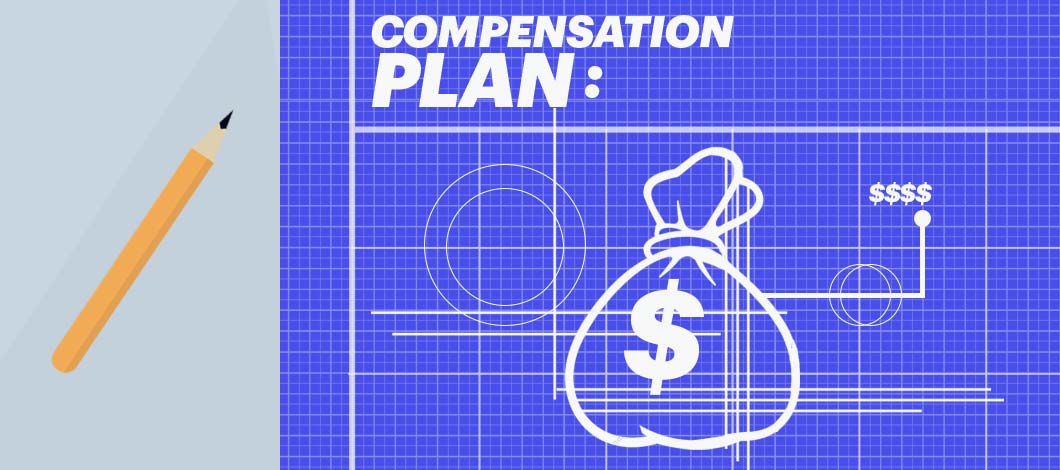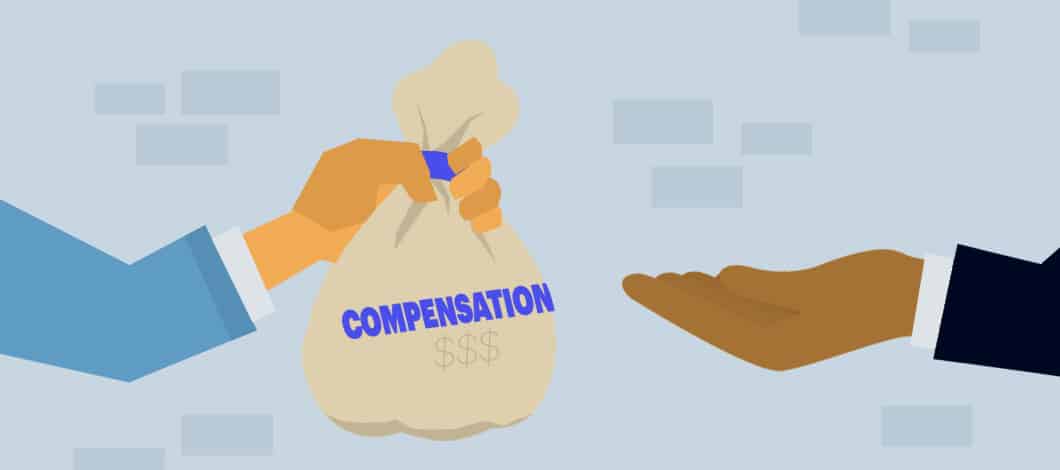A competitive compensation plan can help you attract and keep top talent.
Learn what one is, why you need one and how to design one to keep your topnotch employees.
What Is a Compensation Plan?
A compensation plan consists of all the items in the package you use to compensate employees for their labor, including:
- Wages or salary
- Tips
- Bonuses
- Commissions
- Benefits
- Stock options
A Compensation Plan Example
Let’s illustrate a simple compensation plan for an individual employee first.
You might create a spreadsheet for each employee with rows itemizing compensation components. The top rows can include space for employee identifying information. You can divide the remaining rows into sections for direct compensation, which includes financial payments such as wages or salary, and indirect compensation, which includes benefits such as paid time off, health insurance and retirement savings plans.
For each row, include a column to fill in employee information, payment values or benefit information, along with another column for notes.
You can supplement this essential information with details such as when the employee will become eligible for a raise.
The core of a compensation plan for your entire staff can be structured in a similar way. However, instead of summarizing information for individual employees, it would summarize information for your entire staff. This allows you to consider your entire payroll budget and plan how it will be allocated between employees. A plan for your entire staff can include strategic notes to guide your planning such as:
- A statement of your compensation philosophy
- Goals for your compensation strategy
- Key performance indicators (KPIs) for tracking progress toward your goals
You can adapt these general guidelines to meet your needs. There are many places online where you can download a compensation plan template to help you visualize how to design yours, such as this site from time-tracking software provider Clockify.
Why Do Companies Need Compensation Plans?
Creating compensation plans for individual employees and your staff as a whole can benefit you in a number of ways:
- It supports your recruitment strategy by helping you plan attractive compensation packages to appeal to top talent
- It reinforces your employee retention strategy by helping you develop compensation packages that will make employees want to remain with your company
- It increases employee satisfaction by helping you provide compensation packages that meet employee needs
- Increasing employee satisfaction, promotes higher productivity
- It assists your financial planning efforts by helping you visualize how you will allocate your entire payroll budget
- It allows you to set goals for your compensation program, such as increasing employee satisfaction or retention
- It provides a basis for creating KPIs to track your compensation program’s performance
- By promoting greater productivity and a higher return on investment for your payroll budget, it promotes higher profit margins

What Are the Goals of a Compensation Plan?
When developing compensation plans, you can set different goals depending on what your priorities are.
For example, you might:
- Design or modify your compensation plan with the intent of improving your hiring results
- Create a retention compensation plan designed to reduce turnover rate
- Develop an incentive compensation plan to promote higher performance by offering commissions or bonuses
Considering what the purpose of your compensation plan is before designing it will help you craft a strategy that suits your needs.
Types of Compensation
The elements of compensation plan structures fall into 4 main categories:
- Compensation based on guaranteed payment for labor, such as wages and salaries
- Compensation based on measurable results, such as bonuses or commissions
- Benefits, such as paid time off, sick time, healthcare or retirement savings plans
- Equity-based compensation, such as stock options
The first pair of categories are classified as direct compensation, while the others are classified as indirect compensation.
A compensation program may include any of these categories or combinations of them. In certain industries, one category may be more important. In the sales industry, commissions play a bigger role, for instance.
How to Develop a Compensation Plan: 10 Phases
The steps in designing compensation plan programs can be broken down into 10 phases:
- Assign a compensation manager
- Develop a corporate compensation philosophy
- Set compensation program goals
- Review your compensation budget
- Rank jobs by compensation within your organizational chart
- Identify career advancement opportunities
- Research pay scales and benefits
- Define payroll and benefits administration policies and procedures
- Complete your compensation plan
- Implement and track your compensation program
Each of these steps has its own best practices for successful implementation.
1. Assign a Compensation Manager
The first step in developing a compensation plan program is to designate which staff member will be in charge of developing your plan. This can be the leader of your human resources (HR) department, another staff member or a specialist hired from an HR consulting agency.
2. Develop a Corporate Compensation Philosophy
Articulating a corporate compensation philosophy will help you establish the priorities which will guide your planning. Your philosophical statement should identify how your compensation plan will support your company’s mission and culture.
For example, you might relate your compensation plan to your corporate beliefs and policies about how you will compete in your niche by attracting top talent, how you value your employees or some other aspect of your company culture.
Your philosophy also should indicate which elements your compensation plan will emphasize. For example, will you attract top talent by offering high salaries or will you showcase certain benefits?
3. Set Compensation Program Goals
Guided by your compensation philosophy, you can set goals for your program. Possible goals include:
- Filling specific positions
- Reducing recruitment time and costs
- Increasing employee satisfaction
- Reducing employee turnover
- Retaining top employees during a corporate transition
- Determining how to utilize unused portions of payroll budgets
When applicable, use measurable KPIs to quantify your goals. This will help you track the effectiveness of your program.

4. Review Your Compensation Budget
Your payroll budget will set limits on how much compensation and which benefits you can offer. Keeping your budget in mind will help ensure that your compensation plan is feasible.
If variable payments such as overtime, commissions or bonuses are part of your compensation program, be sure to factor estimates for them into your budget.
If you find that your budget makes it difficult to achieve your compensation program goals, consider whether seeking additional business financing might help.
5. Rank Jobs by Compensation Within Your Organizational Chart
To begin allocating your budget to support your compensation plan, list the jobs on your organizational chart along with their corresponding compensation packages. Include any positions which aren’t currently filled that you plan to fill.
You can then sort your list into tiers based on total compensation, including wages, salary and benefits. For example, executives might occupy one tier, managers a second tier and front-line workers a third tier.
After performing this step, you may find that your compensation levels are inconsistent with your budget or goals. In this case, you may need to revisit your budget and evaluate whether you need to make cuts or seek financing.
6. Identify Career Advancement Opportunities
Job positions are more attractive to employees when there are opportunities for career advancement. Offering advancement opportunities also makes it easier for you to recruit from within, reducing the cost of talent searches.
Review your organizational chart and identify positions that lend themselves to offering advancement opportunities. This can involve an increase in pay after a designated period or promotion to a position with additional responsibilities.
7. Research Pay Scales and Benefits
The best compensation plans are based on solid research into the current job market and what your competitors are offering. The market helps set the expectations of job seekers, and researching it can help you identify which benefits are in demand.
Economic developments can significantly impact job market trends. For example, in 2019, 82.3% of organizations gave base pay raises, but in the wake of the coronavirus pandemic, this dropped to 63.7%, according to a survey by compensation software provider PayScale.
You can research current salary and benefit trends by using resources such as PayScale or the Occupational Employment Statistics database hosted by the Department of Labor’s Bureau of Labor Statistics.
8. Define Payroll and Benefits Administration Policies and Procedures
Successfully implementing your compensation plan will require working out key policy and procedural details for payroll and benefits administration.
For example, you may need to monitor when employees become eligible for pay raises, or you may need to schedule benefits options selection into your onboarding process. Work with your HR team to develop the policies and procedures you need to implement your compensation plan.
9. Complete Your Compensation Plan
Once you know what will go into your compensation plan, it’s time to formalize it as an official document.
You can use a template as suggested above or create your own customized plan. Store your document for reference and review.
10. Implement and Track Your Compensation Program
After your plan has been formalized, you can put it into effect and track your results. Rolling out the plan may require training key personnel and issuing announcements and instructions to your employees.
Following rollout, track the results of your program to evaluate its effectiveness. Use the KPIs you selected when setting your compensation plan goals to gauge how your implementation is working.
If you find you aren’t getting the results you want, consider where you might make adjustments.
Develop a Plan to Retain Top Talent
A compensation strategy that offers attractive pay and compelling benefits can bolster your employee recruitment and retention efforts, helping you draw leading talent to your company and keeping your best workers from getting lured away by competitors.
This translates into a more efficient, more productive workforce and lower costs for talent searches, ultimately increasing your profit margin.
An effective compensation strategy depends on a sound financing strategy to cover the costs of pay and benefits. If you require capital to invest in developing a winning compensation strategy, consider business financing options such as small business loans. To find out which loan options may be available to you, take a few minutes to fill out our free online prequalifying application.










